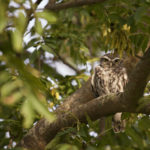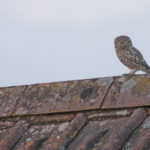
Local info | Description, habitat & diet | Breeding and survival | Gallery | Video
This small owl was introduced to the UK in the 19th century. It can be seen in the daylight, usually perching on a tree branch, telegraph pole or rock. It will bob its head up and down when alarmed. In flight it has long, rounded wings, rapid wingbeats and flies with a slight undulation.
Breeding Bird Survey data suggest that Little owl numbers are declining, with the UK population estimated to be down by 24 per cent between 1995 and 2008.
In Gloucestershire
Introduced in to Britain in the late 19th century, the first reliable record of a Little Owl in the county dates back to 1908, with the first breeding record being in 1916. They use a range of different habitats in the county, particularly farmland in the Cotswolds and old orchards in the Severn Vale and elsewhere. Little Owls occur in most parts of the county, but along with national trends, they have shown a continual decline for at least 20 years.
Size, habitat and diet
Length: 22cm
Wingspan: 56cm
Weight: M/F: 180g
World distribution: Europe, C&S Asia, N&C Africa
Habitat: Steppe, farmland, towns, open woodland
Diet: Mostly small mammals and birds, large invertebrates (e.g. beetles, crickets, worms), nocturnal
Breeding and survival
Clutch size: 3-4 eggs
Incubation: 29-31 days
Fledging: 37-40 days
Number of broods: 1(2)
Age at first breeding: 1 year
Typical lifespan: 3 years
What’s inside a Little Owl pellet? (Bird Watching Magazine)
[youtube https://www.youtube.com/watch?v=w9KBLLJ6mXA?rel=0&w=420&h=315]






